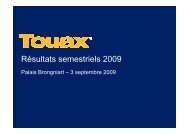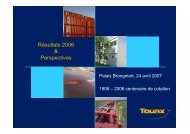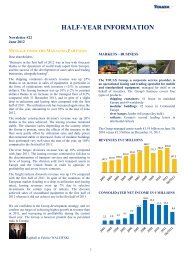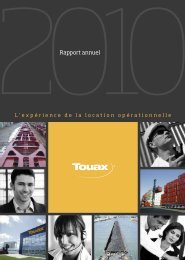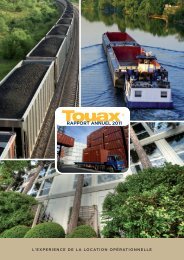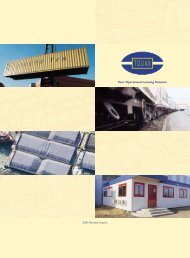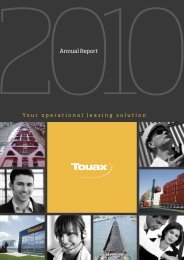2005 Annual Report - Touax
2005 Annual Report - Touax
2005 Annual Report - Touax
Create successful ePaper yourself
Turn your PDF publications into a flip-book with our unique Google optimized e-Paper software.
note 1.5. Translation of foreign currencies<br />
note 1.5.1. Translation of financial statements<br />
in currencies of foreign subsidiaries<br />
The Group’s operating and presentation currency is<br />
the euro.<br />
The operating currency of foreign companies is<br />
generally the local currency. Where the majority of<br />
transactions are effected in a third currency, the<br />
operating currency is this third currency.<br />
The financial statements of the Group’s foreign companies<br />
are prepared in their operating currency. The<br />
financial statements of foreign companies are translated<br />
into the Group’s presentation currency (euro)<br />
as follows:<br />
2 the assets and liabilities of foreign subsidiaries<br />
are translated into euros at the closing exchange<br />
rate;<br />
2 shareholders’ equity, maintained at the historic<br />
rate, is translated at the closing rate;<br />
2 the income statements and cash flows are translated<br />
at the average exchange rate for the period;<br />
2 losses or gains resulting from the translation of<br />
the financial statements of foreign companies are<br />
carried in a translation reserve included in consolidated<br />
shareholders’ equity.<br />
Goodwill generated when a foreign company is<br />
acquired is entered in the operating currency of the<br />
acquired company. It is then translated, at the closing<br />
rate, into the Group’s presentation currency.<br />
The differences resulting from this translation are<br />
carried in consolidated shareholders’ equity.<br />
In accordance with the option authorized by IFRS 1<br />
“First-time adoption of IFRS”, the Group has chosen<br />
to reclassify under “Consolidation reserves” the<br />
“Translation reserves” accumulated as at 1 January<br />
2004 resulting from the translation of the financial<br />
statements of foreign subsidiaries.<br />
When a foreign subsidiary is sold, the currency<br />
translation differences accumulated in the<br />
“Translation reserves” account since 1 January 2004<br />
are taken to the income statement as a component<br />
of the profit or loss on the disposal.<br />
note 1.5.2. Translation of transactions in foreign<br />
currencies<br />
Transactions in foreign currencies effected by<br />
consolidated companies are converted into their<br />
operating currency at the exchange rates prevailing<br />
on the date of the transaction.<br />
Monetary assets and liabilities in foreign currencies<br />
are translated at the exchange rate on the closing<br />
date. Differences resulting from this translation<br />
(unrealized gains and losses) are stated in the financial<br />
result.<br />
Currency differences relating to a monetary element<br />
which, in substance, forms an integral part of the net<br />
investment in a consolidated foreign subsidiary are<br />
entered in shareholders’ equity (in the “Translation<br />
reserves” item) up until the time of disposal or liquidation<br />
of this net investment.<br />
note 1.6. Accounting for asset securitization<br />
transactions<br />
Asset securitization transactions have been effected<br />
in the “Shipping Containers” business with the creation<br />
of the trusts CLR 95, TCLRT 98 and TLR 2001,<br />
and in the “Modular Buildings” business with the<br />
formation of GIE Modul Finance I.<br />
These securitization transactions have enabled the<br />
Group to increase its capacity as an operating lessor<br />
by calling upon external investors to acquire the<br />
assets necessary for the Group’s leasing and service<br />
activities and to provide the financing.<br />
Each of these securitization transactions has been<br />
analyzed in detail and in substance in the light of<br />
interpretation SIC 12 “Consolidation – Special<br />
Purpose Entities (cf. below). On this basis, the Group<br />
does not control any special purpose entities.<br />
Consequently, the Trusts and GIE Modul Finance I<br />
are not consolidated by the TOUAX Group.<br />
These transactions and their impacts on the financial<br />
statements are described in the notes to the<br />
consolidated financial statements note 27.6 page 89,<br />
note 27.7 page 91, note 27.8 page 92 and note 27.9<br />
page 95).<br />
■ Analysis of asset securitization transactions<br />
Paragraph 10 of SIC 12 states: “In addition to the<br />
situations described in IAS 27.13, the following circumstances,<br />
for example, may indicate a relationship<br />
in which an entity controls an SPE [special purpose<br />
entity] and consequently should consolidate the SPE<br />
(additional guidance is provided in the Appendix to this<br />
Interpretation):<br />
(a) in substance, the activities of the SPE are being<br />
conducted on behalf of the entity according to its specific<br />
business needs so that the entity obtains benefits<br />
from the SPE’s operation;<br />
(b) in substance, the entity has the decision-making<br />
powers to obtain the majority of the benefits of the activities<br />
of the SPE or, by setting up an “autopilot” mechanism,<br />
the entity has delegated these decision-making<br />
powers;<br />
(c) in substance, the entity has rights to obtain the<br />
majority of the benefits of the SPE and therefore may<br />
be exposed to risks incident to the activities of the<br />
SPE; or<br />
(d) in substance, the entity retains the majority of the<br />
residual or ownership risks related to the SPE or its<br />
assets in order to obtain benefits from its activities.”<br />
annual report <strong>2005</strong><br />
Consolidated accounts<br />
53



